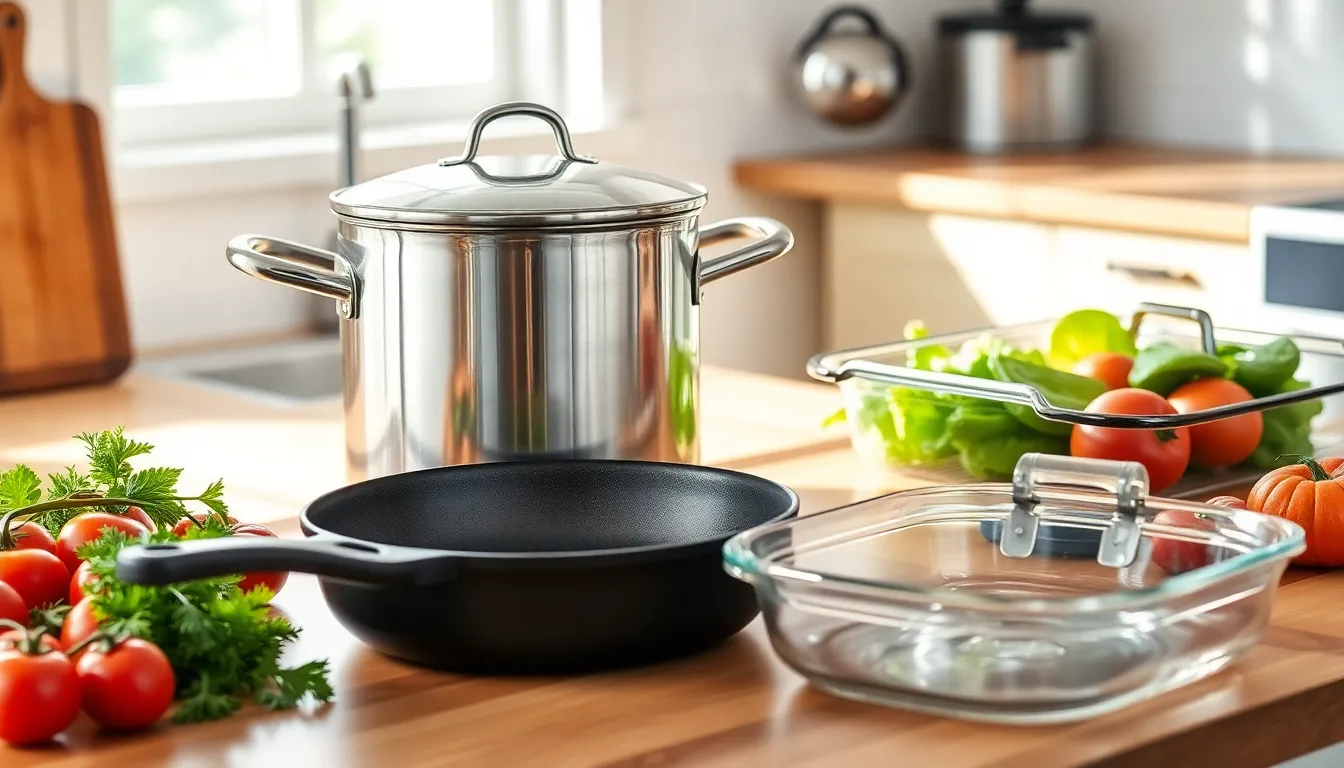Wondering what kind of cookware is safe for your family’s health? With countless options on the market—from stainless steel to non-stick, cast iron to ceramic—it’s easy to feel overwhelmed when choosing kitchen essentials that won’t leach harmful chemicals into your food.
Your cookware choices matter more than you might think. Many popular pots and pans contain materials like PFOA, lead, or cadmium that can contaminate meals when heated. Selecting safe, non-toxic cookware isn’t just about quality cooking—it’s about protecting your long-term health and the wellbeing of those you love.
Understanding Cookware Safety Concerns
Cookware safety involves more than just preventing kitchen accidents—it’s about the chemical interactions between your cooking vessels and food. Many common pots and pans release compounds during cooking that can accumulate in your body over time, potentially leading to health issues.
Common Toxins in Cookware
Several harmful substances lurk in everyday cookware materials. PFAS (per- and polyfluoroalkyl substances) coat many non-stick pans, creating that slippery surface but leaching into food when scratched or overheated. Heavy metals like lead and cadmium appear in some ceramic glazes, especially in brightly colored or decorative pieces from unregulated manufacturers. Aluminum cookware releases metal particles during cooking, particularly with acidic foods like tomatoes or citrus. BPA and phthalates exist in plastic cooking utensils and storage containers, disrupting hormonal balance when they migrate into foods. These toxic compounds enter your system gradually through regular cooking, making their impact difficult to detect until health problems develop.
Stainless Steel Cookware: A Safe and Durable Option
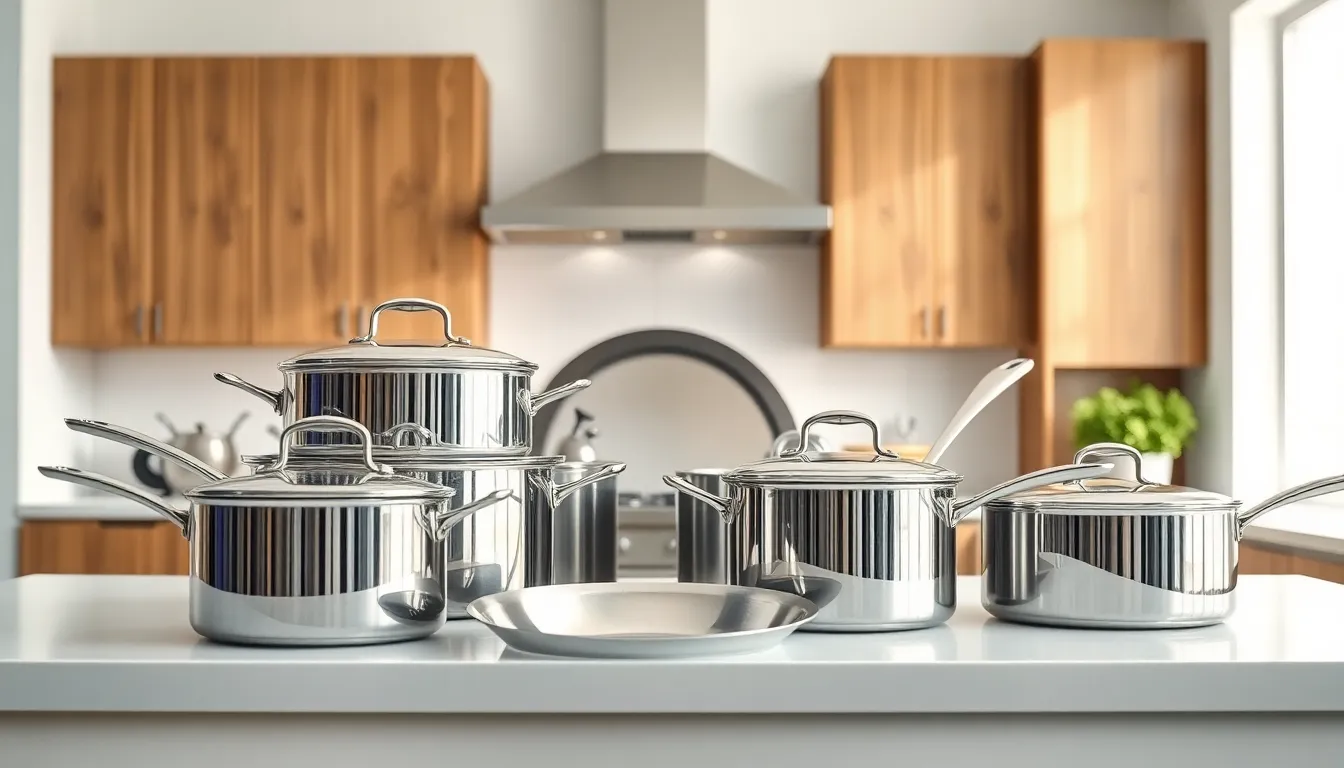
Stainless steel cookware stands as one of the safest options for your kitchen arsenal. Its combination of safety features, longevity, and versatile cooking capabilities makes it a popular choice among both home cooks and professional chefs.
Benefits of Stainless Steel
Stainless steel offers exceptional safety for daily cooking tasks because it doesn’t leach harmful chemicals into food, even at high temperatures. Your acidic ingredients like tomato sauce or lemon juice won’t react with the metal surface, eliminating concerns about contamination during cooking. This non-reactive property ensures your food maintains its intended flavor profile without metallic aftertastes.
Durability represents another important advantage of stainless steel cookware. Premium-grade options like 18/10 or 304 stainless steel resist scratches, dents, rust, and corrosion remarkably well, often lasting decades with proper care. Many stainless steel pots and pans incorporate aluminum or copper cores, improving heat distribution and eliminating problematic hot spots during cooking.
Maintenance couldn’t be simpler with stainless steel. Most pieces are dishwasher safe and don’t require the special seasoning or treatment needed for materials like cast iron. The smooth, non-porous surface wipes clean easily and resists staining, making it perfect for busy households seeking practical cookware answers.
Potential Drawbacks to Consider
Metal leaching presents a minor concern with certain stainless steel grades. Small amounts of nickel or manganese can transfer to food, particularly when cooking acidic dishes for extended periods. People with nickel sensitivities might prefer lower-nickel grades such as 439 stainless steel to minimize potential reactions.
Heat conduction limitations exist with pure stainless steel, which doesn’t conduct heat as effectively as materials like copper or aluminum. Quality manufacturers address this issue by incorporating aluminum or copper bases in their designs, though these multi-layered options typically come with higher price tags.
Cost factors into purchasing decisions, as high-quality stainless steel cookware represents a more important investment compared to some alternative materials. Premium sets with copper or aluminum cores can reach substantial price points, though their exceptional durability often justifies the initial expense through years of reliable service.
Cast Iron Cookware: Traditional and Reliable
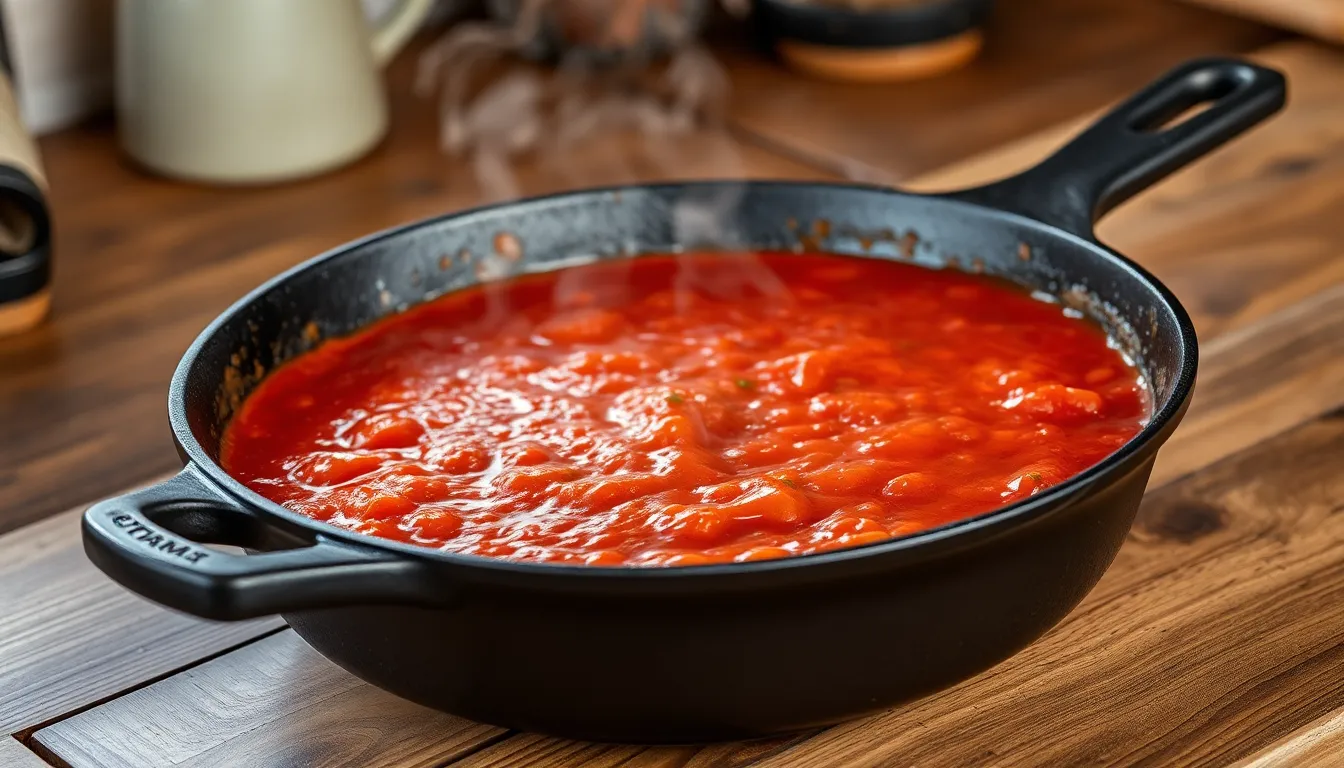
Cast iron cookware stands as one of the safest options for your kitchen, combining centuries-old tradition with remarkable durability. Its naturally nonstick surface when properly seasoned eliminates the need for synthetic coatings that might contain harmful chemicals. The exceptional heat retention and even distribution make cast iron ideal for various cooking methods including searing, frying, and baking.
Health Benefits of Cooking with Cast Iron
Cooking with cast iron provides a unique nutritional advantage by naturally fortifying your food with dietary iron. The cookware actually leaches small amounts of iron into food during the cooking process, which can be beneficial for individuals with iron deficiency. This natural supplementation occurs most notably when preparing acidic foods like tomato-based sauces. Regular use of cast iron pans contributes to increased iron intake without the need for supplements. Those with hemochromatosis or other iron overload conditions should exercise caution when using uncoated cast iron and might prefer enameled versions that minimize iron transfer.
Proper Maintenance for Safe Use
Maintaining your cast iron cookware correctly ensures both its safety and longevity. Clean your pans while still warm using warm water and a stainless-steel chainmail scrubber to remove food residues without damaging the seasoning. Mild soap can be used occasionally without harming the pan’s surface, contrary to popular myths about soap ruining cast iron. Dry your cookware immediately after washing to prevent rust formation. Apply a thin layer of oil, such as coconut oil, before storing to maintain the seasoning and prevent oxidation.
The natural nonstick surface of cast iron develops through proper seasoning, so avoid harsh detergents or extended soaking that could strip this protective layer. Enameled cast iron offers an alternative that’s easier to clean and limits iron leaching, though it requires careful handling to prevent chips in the enamel coating. With proper care, cast iron cookware can last for generations, making it not only a safe choice but also an environmentally sustainable one.
Ceramic and Enameled Cookware Safety
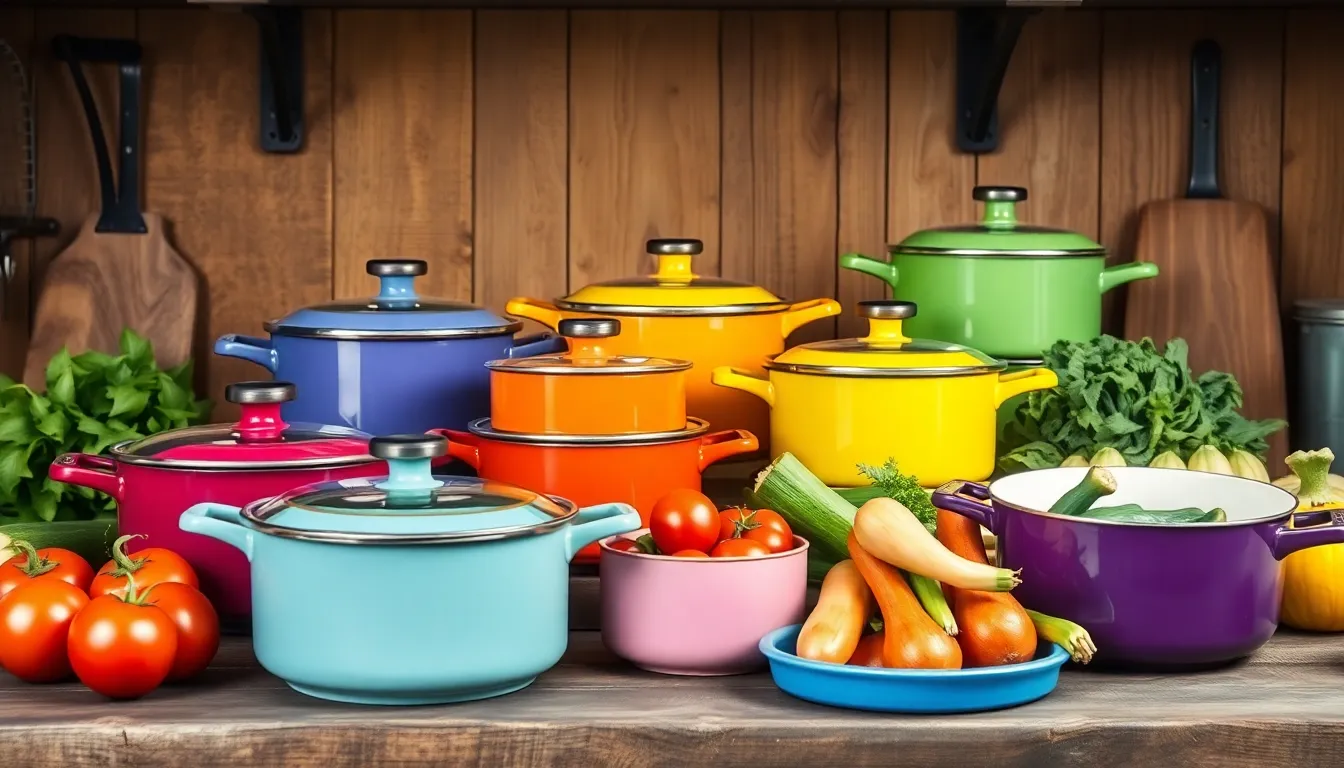
Ceramic and enameled cookware offers an attractive alternative to other cooking materials, combining aesthetic appeal with functional cooking properties. These options have gained popularity for their vibrant colors and potentially non-toxic nature, but understanding their safety profile is essential before making a purchase.
Lead and Cadmium Concerns
Ceramic cookware manufacturing processes sometimes involve lead or cadmium, particularly in the glazes that give these pots and pans their colorful finish. The FDA monitors enamel coatings for lead levels, establishing regulatory limits to protect consumers. Reputable manufacturers typically ensure their products don’t contain these harmful metals, though the risk remains higher with imported or artisanal pieces from countries with less stringent regulations. Exposure to these heavy metals occurs primarily when acidic foods come into contact with compromised ceramic surfaces, potentially releasing toxins into your meals over time.
What to Look for When Purchasing
Third-party certifications provide the strongest assurance of safety when shopping for ceramic or enameled cookware. Look for explicit statements about being lead-free and cadmium-free on packaging or product descriptions. Established brands like Greenpan or Healthy Legend carry out strict quality control measures to minimize potential toxicity risks. Extremely low-priced ceramic nonstick options often indicate corners cut during production, possibly at the expense of safety standards. Consider checking for titanium dioxide nanoparticles in ceramic nonstick cookware—these particles become problematic if the surface gets scratched or exposed to very high temperatures. Enamel-coated cast iron represents a safer alternative when certified lead-free, though using non-metal utensils helps preserve the protective coating and prevents potential leaching issues.
Glass Cookware: The Non-Reactive Choice
Glass cookware stands out as one of the safest options for health-conscious cooking due to its completely inert nature. It’s a popular choice among those looking to eliminate potential toxins from their kitchen while maintaining versatility in cooking applications.
Advantages of Glass Cooking Vessels
Glass cookware offers exceptional safety benefits as it doesn’t leach chemicals or heavy metals into your food. The non-reactive properties make it particularly ideal for acidic dishes like tomato sauces, citrus-based marinades, or vinegar dressings that might cause reactions with other materials. Glass distributes heat evenly throughout your dishes, ensuring consistent cooking results whether you’re baking casseroles, roasting vegetables, or preparing lasagna. Many home cooks appreciate the transparency of glass, allowing you to monitor cooking progress without lifting lids. Brands like Pyrex have established reputations for creating durable glass cookware that transitions seamlessly from oven to table, reducing the need for additional serving dishes. Glass containers also excel as food storage options, letting you cook, store, and reheat in the same vessel without worrying about chemical contamination.
Safety Precautions for Glass Cookware
Glass cookware requires exact handling techniques to prevent breakage from thermal shock. Avoid exposing your glass bakeware to sudden temperature changes, such as moving it directly from refrigerator to hot oven or placing hot glassware on cold, wet surfaces. Always place hot glass dishes on dry potholders, trivets, or folded kitchen towels rather than directly on cool countertops. Check your glass cookware regularly for tiny chips, cracks, or scratches that might compromise structural integrity and lead to unexpected breakage during use. Glass performs best in oven applications rather than on direct stovetop heat, so reserve your glass pieces primarily for baking, roasting, and food storage. Preheat your oven before inserting glass cookware to minimize temperature stress, and allow dishes to cool naturally before cleaning to extend their lifespan. Following these precautions ensures your glass cookware remains a safe, reliable kitchen companion for years of healthy cooking.
Non-Stick Cookware: Weighing the Risks
Non-stick cookware offers convenience but comes with potential health considerations that deserve careful examination. Understanding these risks helps you make informed decisions about the cookware you bring into your kitchen.
PFOA and PTFE Concerns
Non-stick cookware typically contains PTFE (commonly known as Teflon), which belongs to the PFAS chemical group. Modern non-stick pans have eliminated PFOA—a chemical previously linked to health issues—making them safer than older versions. But, PTFE still presents concerns when damaged or overheated. Heating non-stick pans beyond 500°F can cause the coating to break down and release potentially harmful fumes. These particles might enter food when cooking with scratched or chipped surfaces, creating long-term exposure risks. Research indicates that with proper usage and maintenance (avoiding metal utensils and high-heat cooking methods), non-stick cookware remains relatively safe for everyday use.
Newer Non-Stick Technologies
Innovative alternatives to traditional non-stick coatings have emerged to address health concerns. Ceramic-based non-stick surfaces offer PFOA and PTFE-free cooking options with excellent food release properties. Silicon-based coatings provide another safer alternative that resists higher temperatures than conventional non-stick surfaces. These newer technologies deliver the convenience of non-stick cooking without the same chemical concerns, though they often don’t match the durability of traditional Teflon. Many manufacturers now produce hybrid options that balance safety with longevity, using reinforced ceramic materials or multi-layer systems. When shopping for these alternatives, look for exact certifications indicating the absence of PFAS compounds to ensure you’re getting truly safer cookware.
Copper Cookware: Beautiful but Requires Caution
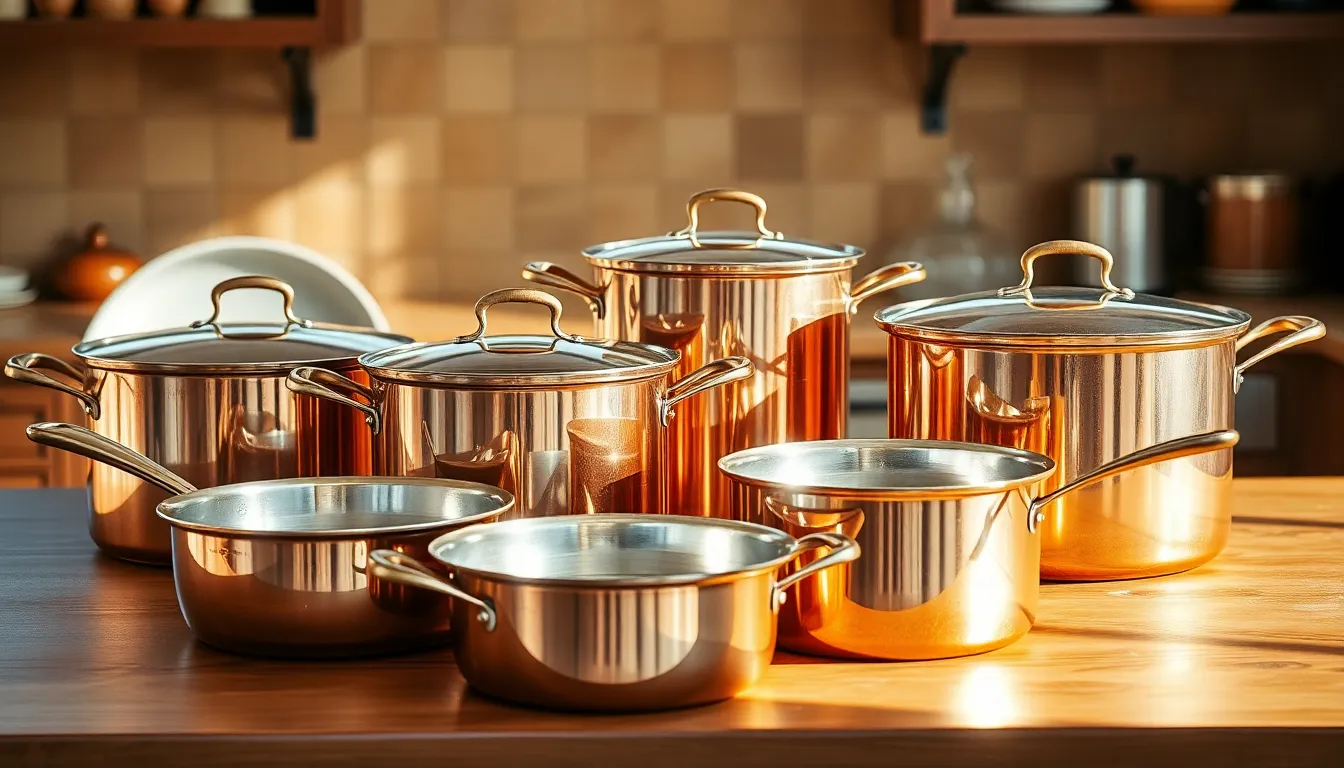
Copper cookware combines stunning aesthetic appeal with exceptional heat conductivity, making it a favorite among professional chefs and home cooking enthusiasts. This premium material requires special consideration to ensure safe food preparation and longevity of your investment.
Lined vs. Unlined Copper Pans
Unlined copper pans showcase copper’s superior heat conductivity properties but come with important limitations. They’re excellent for exact cooking tasks like preparing eggs or flour-based dishes that don’t contain acidic ingredients. Copper’s remarkable ability to distribute heat evenly makes these pans ideal for delicate temperature-sensitive preparations.
Lined copper cookware offers the best of both worlds by featuring a protective inner layer of tin or stainless steel. This non-reactive lining prevents copper from coming into direct contact with your food, creating a safer cooking surface for all types of ingredients. The lining provides a natural non-stick surface that enhances the cookware’s versatility, allowing you to prepare anything from tomato sauces to lemon-based dishes without concern for metal leaching.
Safe Usage Guidelines
Following proper safety protocols ensures your copper cookware remains both beautiful and safe for daily use. Never use unlined copper pans with acidic foods like tomatoes, citrus, or vinegar-based sauces as these ingredients can react with copper and potentially leach harmful compounds into your meals.
Lined copper pans offer greater flexibility but require regular inspection to ensure the lining remains intact. Check your cookware periodically for signs of wear or damage to the inner lining, particularly with tin-lined pieces which may need re-tinning every few years with regular use.
Maintain your copper cookware by cleaning it properly after each use with mild soap and warm water rather than harsh abrasives that might damage the lining. Polishing the exterior with appropriate copper cleaners keeps the stunning exterior looking its best while protecting the structural integrity of the piece.
Choosing the Right Cookware for Your Kitchen
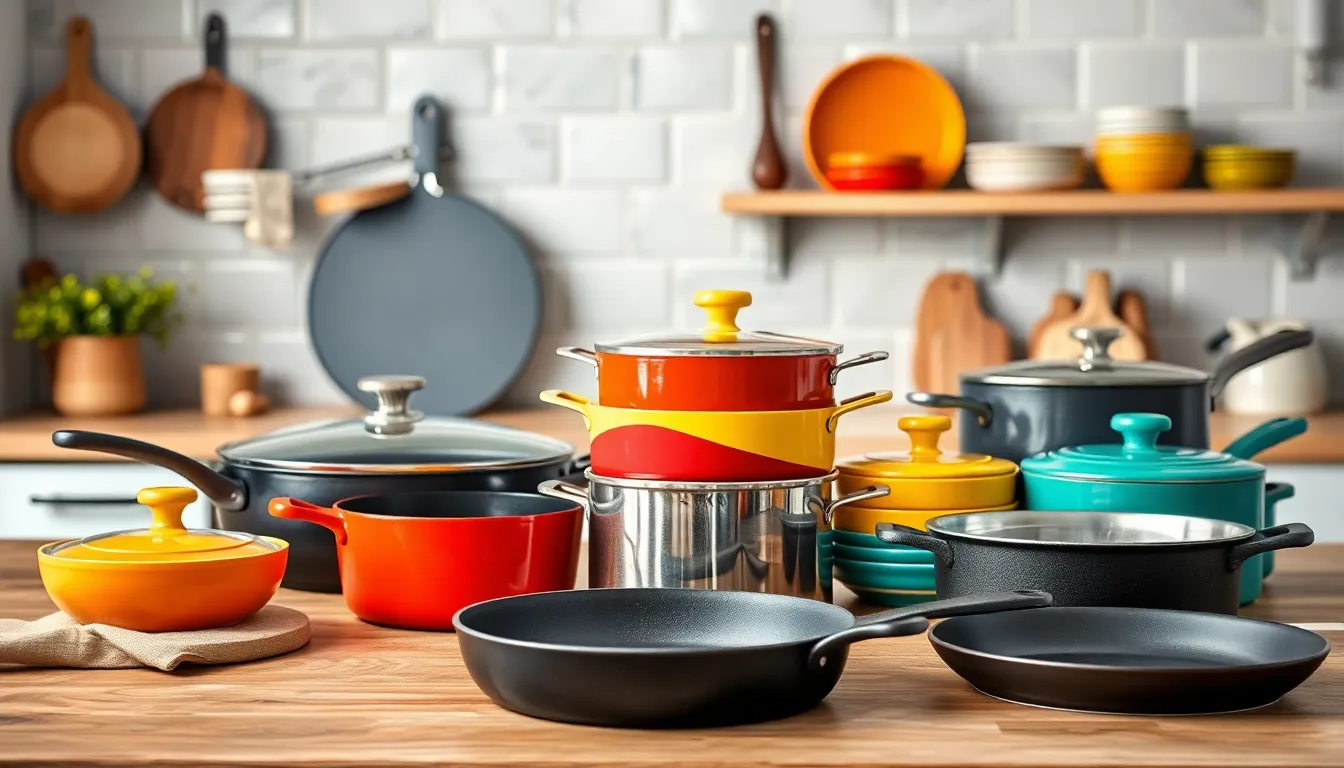
Safe cookware selection involves understanding which materials don’t leach harmful chemicals or heavy metals into your food. The safest cookware materials in 2025 include uncoated cast iron, high-quality stainless steel, glass, lead-free ceramic, enamel-coated cast iron, and carbon steel.
Matching Cookware to Your Cooking Style
Different cooking methods require exact cookware materials for optimal results and safety. Cast iron and carbon steel excel at high-heat cooking tasks like searing steaks or stir-frying vegetables due to their exceptional heat retention and durability. Ceramic nonstick pans provide the perfect surface for delicate foods such as eggs or fish without releasing toxins during cooking. Stainless steel serves as the ultimate versatile option for everyday cooking, handling everything from pasta sauces to vegetable stir-fries without concerns about chemical leaching. Glass and ceramic cookware distribute heat evenly throughout baking dishes, creating consistent results for casseroles, bread, and desserts. Matching your primary cooking techniques to appropriate cookware materials ensures better culinary outcomes while maintaining food safety standards.
Budget-Friendly Safe Options
Quality cookware doesn’t always require very costly. Cast iron ranks among the most cost-effective safe cookware options available, often lasting generations with proper care and maintenance. A well-seasoned cast iron skillet costing $20-40 delivers decades of cooking performance, making it an exceptional value investment. Stainless steel cookware offers another affordable yet durable choice, with mid-range sets providing excellent safety profiles and versatility without premium pricing. Budget ceramic options exist but require careful consideration – less expensive versions may wear faster and tolerate less heat than premium counterparts. Look for sales on trusted brands rather than choosing the absolute cheapest unknown manufacturers, as safety certifications matter significantly with ceramic and enamel-coated products. Wooden or silicone utensils protect your cookware investment regardless of material choice, preventing scratches that might compromise safety coatings over time.
Conclusion
Choosing safe cookware is an investment in your family’s long-term health. By understanding the benefits and drawbacks of stainless steel cast iron ceramic glass copper and newer non-stick technologies you’re empowered to make smarter kitchen decisions.
Remember that the safest options include high-quality stainless steel properly maintained cast iron lead-free ceramic glass and carefully selected enamel-coated products. These materials offer durability functionality and peace of mind.
Your cooking style budget and health priorities will eventually guide your selection. While premium cookware might cost more initially its longevity often provides better value over time. Always verify safety certifications and proper care instructions to maximize both performance and safety in your kitchen.
Frequently Asked Questions
What makes cookware unsafe for cooking?
Cookware becomes unsafe when it contains materials like PFOA, lead, or cadmium that can leach into food when heated. Chemical interactions between cooking vessels and food can lead to toxin accumulation in the body over time. Non-stick pans with PFAS, ceramic glazes with heavy metals, aluminum particles, and plastics with BPA are common culprits. These toxins can cause health issues that may not become apparent until significant exposure has occurred.
Is stainless steel cookware completely safe?
Stainless steel is one of the safest cookware options available. It’s non-reactive, durable, and doesn’t leach harmful chemicals into food under normal cooking conditions. High-quality stainless steel is resistant to scratches, rust, and corrosion. However, lower-grade stainless steel may release small amounts of nickel and chromium when cooking acidic foods. For maximum safety, choose high-quality 18/10 or 18/8 stainless steel from reputable manufacturers.
How do I know if my ceramic cookware contains lead or cadmium?
Purchase ceramic cookware from reputable manufacturers who adhere to safety regulations and look for third-party certifications confirming products are lead-free and cadmium-free. Avoid extremely low-priced ceramic options, which may compromise on safety standards. Established brands typically test their products for heavy metals and will advertise compliance with safety standards. When in doubt, contact the manufacturer directly to request test results.
Can cast iron cookware add iron to my food?
Yes, cast iron cookware can naturally fortify your food with dietary iron, which is particularly beneficial for those with iron deficiency. The amount of iron that leaches into food depends on the acidity of the food, cooking time, and how well-seasoned the pan is. Properly seasoned cast iron develops a natural non-stick patina that limits excessive iron transfer. For those concerned about too much iron, enameled cast iron provides an alternative that limits iron leaching.
Are non-stick pans still dangerous to use?
Modern non-stick pans are safer than older versions that contained PFOA, but concerns remain about PTFE (Teflon) releasing harmful fumes when overheated or damaged. Newer non-stick technologies using ceramic and silicon-based coatings offer safer alternatives without the same chemical concerns. When purchasing non-stick cookware, look for certifications indicating the absence of PFAS compounds, and always avoid high heat and metal utensils that can damage the coating.
What is the safest cookware material overall?
The safest cookware materials are uncoated cast iron, high-quality stainless steel, glass, lead-free ceramic, enamel-coated cast iron, and carbon steel. These materials don’t leach harmful chemicals or heavy metals into food when properly used and maintained. Glass is completely non-reactive, while cast iron and carbon steel develop natural non-stick surfaces. For versatile everyday cooking, stainless steel offers excellent safety combined with durability and ease of use.
How does cooking method affect cookware safety?
Different cooking methods require specific cookware materials for optimal results and safety. High-heat cooking tasks like searing and stir-frying are best done in cast iron or carbon steel. Delicate foods that might stick benefit from ceramic non-stick surfaces. Acidic foods should be prepared in non-reactive materials like stainless steel or glass. Slow-cooking dishes do well in enameled cast iron, while baking is safest in glass or ceramic.
Can I find safe cookware on a budget?
Yes, quality cookware can be affordable. Cast iron is extremely durable and relatively inexpensive, often lasting generations with proper care. Basic stainless steel sets from reputable manufacturers offer excellent value and safety. Look for cookware on sale at the end of seasons or consider building your collection gradually, focusing on versatile pieces first. Always prioritize safety certifications over fancy features, and remember that long-lasting cookware provides better value over time.
How should I maintain copper cookware to ensure it’s safe?
Properly maintain copper cookware by avoiding acidic foods in unlined pans and regularly inspecting lined pans for wear or damage to the lining. Clean copper with gentle soaps and soft cloths, avoiding abrasive cleaners that can damage protective linings. Special copper cleaners can restore the exterior shine without affecting the cooking surface. Never overheat copper pans, as extreme temperatures can damage linings and potentially release harmful substances into food.
Is glass cookware completely safe for all types of cooking?
Glass cookware is among the safest options available as it’s completely non-reactive and doesn’t leach chemicals or heavy metals into food. It’s ideal for acidic dishes and provides even heat distribution. However, glass requires careful handling to prevent breakage from thermal shock. Never place hot glass cookware on cold surfaces or add cold liquids to hot glass. Most glass cookware isn’t suitable for stovetop-to-oven transitions unless specifically designed for that purpose.
